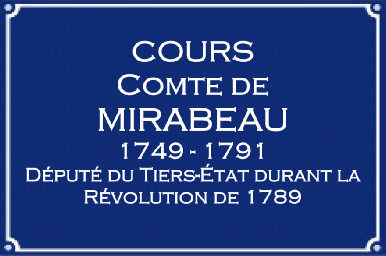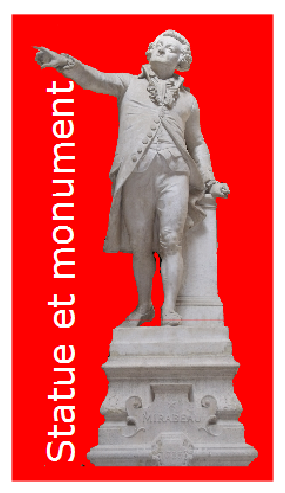


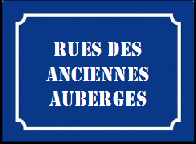



















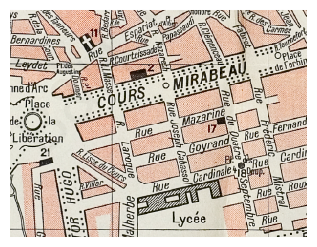


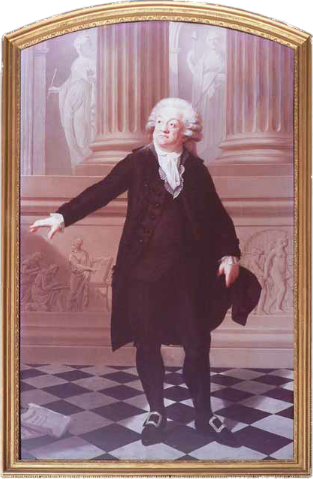
Honoré Gabriel RIQUETI, comte de MIRABEAU, est né au Château de Bignon (Loiret) le 9 mars 1749.
Il souffre de malformations congénitales avec un pied tordu et une tête de taille supérieure à la moyenne. De plus, à l'âge de trois ans, la variole ou « petite vérole » qu'il contracte lui rend le visage hideux. Sa mère pensait qu’il ne séduirait jamais aucune femme. Tout au contraire, Honoré Gabriel deviendra un grand séducteur. Il sera sévèrement éduqué pour tous ses écarts de bonne conduite par son père. Celui-
Vers 20 ans, il étudie à la Faculté de droit de l’Université d’Aix en compagnie de Jean-
En 1783, il n’a que 34 ans quand il intente à sa femme, Émilie de MARIGNANE, le célèbre « procès d’Aix ». Il veut la forcer à reprendre la vie commune mais surtout jouir de la fortune dont elle vient d’hériter. Elle est défendue par le même PORTALIS et le comte de MIRABEAU est débouté, mais son éloquence fera impression.
En 1789, au début de la Révolution française, repoussé par la noblesse il publie alors un discours déchaîné adressé aux nobles provençaux. Après celui-
Le comte de MIRABEAU meurt à Paris le 2 avril 1791, à l’âge de 42 ans.
Le saviez-
Il fut le premier personnage illustre à être inhumé au Panthéon. Mais la Convention du 12 septembre 1794 révèle qu'il soutenait clandestinement LOUIS XVI : sa dépouille est la première à être expulsée du Panthéon et remplacée par celle de MURAT.
À voir :
La Statue du comte de MIRABEAU se trouve dans la salle des pas perdus du Palais de Justice. Une imposante statue qui ornait la Place des PRÊCHEURS depuis 1926 sera détruite en octobre 1963.
Honoré Gabriel RIQUETI, count of MIRABEAU, was born at the Château de Bignon (Loiret) on March 9, 1749.
He suffers from birth defects with a crooked foot and an above-
Around the age of 20, he studied at the Law Faculty of the University of Aix with Jean-
In 1783, he was only 34 years old when he initiated the famous "Aix trial" against his wife, Émilie de MARIGNANE. He wants to force her to resume living together but above all to enjoy the fortune she has just inherited. She is defended by the same PORTALIS and the count of MIRABEAU is rejected, but her eloquence will make an impression.
In 1789, at the start of the French Revolution, repulsed by the nobility, he then published a wild speech addressed to the Provençal nobles. After the latter, called by his supporters, he chose to be Aix's representative for the Third Estate at the National Assembly. Subsequently, he defended the rights to freedom of the press with the publication of Courrier de Provence; he will participate in the drafting of the Rights of Man and of the Citizen and will support the requisition of the goods of the clergy. It is at the origin of the departmental division of France. He will be nicknamed "The Orator of the People" or "The Torch of Provence".
Count de MIRABEAU died in Paris on April 2, 1791, at the age of 42.
Did you know ?
He was the first famous person to be buried in the Pantheon. But the Convention of September 12, 1794 reveals that he secretly supported LOUIS XVI: his remains were the first to be expelled from the Pantheon and replaced by that of MURAT.
To see :
The Statue of the Count of MIRABEAU is in the Salle des Pas Perdus of the Palais de Justice. An imposing statue which adorned the Place des PRÊCHEURS since 1926 will be destroyed in October 1963.
